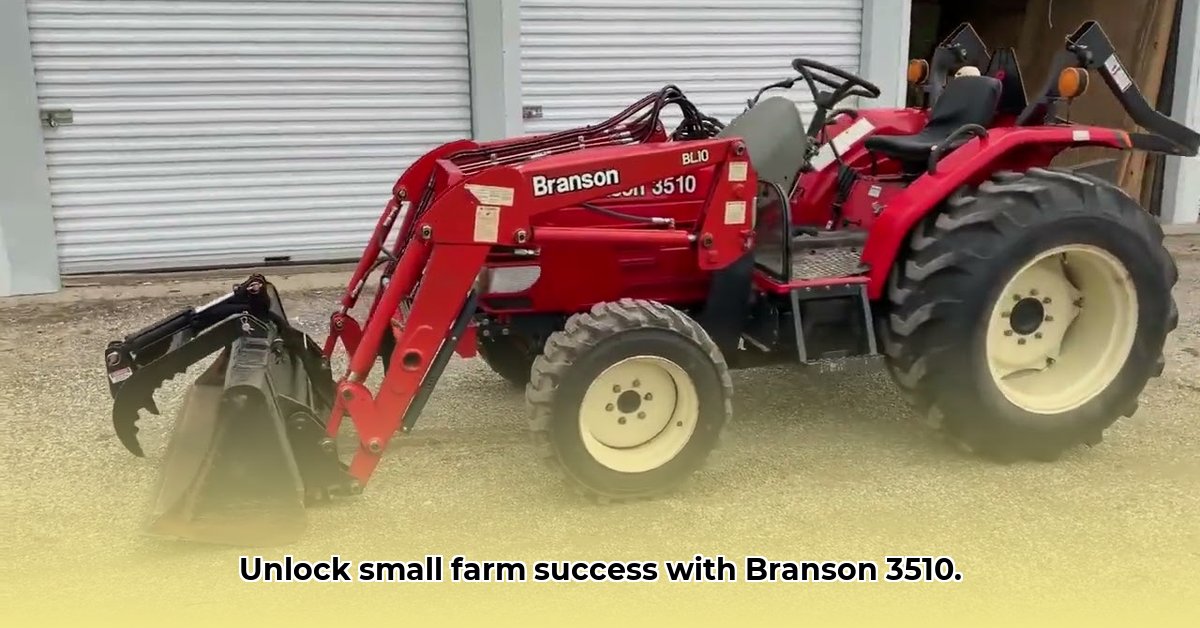
The Branson 3510 tractor, though no longer in production, remains a valuable asset for sustainable small-scale farming. Its compact design and robust capabilities make it a compelling choice for farmers prioritizing efficiency and environmental responsibility. This guide explores its strengths and weaknesses to help you determine if a used Branson 3510 is the right fit for your operation. For more information on finding the right tractor for your needs, check out this resource on tractor mower decks.
Power and Performance: A Workhorse for the Small Farm
The Branson 3510 boasts a 35-horsepower engine (sufficient for many small-scale farming tasks) coupled with a 12-speed transmission, offering flexibility for various applications. From tilling and mowing to hay baling, this tractor provides the power needed for diverse operations. Its hydrostatic power steering significantly enhances maneuverability, especially in confined spaces common to smaller farms. Wouldn't easier steering in tight rows significantly improve your efficiency? The live PTO (power take-off) system seamlessly integrates with various implements, further optimizing productivity. However, the 35 horsepower might be insufficient for larger farms or exceptionally demanding tasks.
Size and Maneuverability: A Nimble Friend in the Field
The Branson 3510’s compact design is a key advantage for small farms. Its smaller footprint allows for easier navigation in tight spaces, reducing the risk of crop damage. This agility translates to better fuel efficiency--a significant savings over time. Consider the fuel costs saved by being able to easily maneuver in limited spaces – optimizing your fuel budget.
Maintenance and Durability: Planning for the Long Haul
As a discontinued model, securing parts for the Branson 3510 may require more effort. Research the availability of parts in your area and identify mechanics familiar with this tractor before purchasing. Regular preventative maintenance is crucial for longevity. This proactive approach is essential not just for the tractor, but for maintaining a sustainable small farm operation. What are your strategies for securing parts and maintaining your equipment?
Sustainability: The Eco-Friendly Choice
The Branson 3510's fuel efficiency contributes to sustainable farming. Its smaller engine generally consumes less fuel than larger tractors, resulting in both cost savings and a smaller carbon footprint. How important is fuel efficiency in your decision-making process when considering sustainable practices?
Pros and Cons: Weighing the Options
Here's a balanced assessment of the Branson 3510:
| Pros | Cons |
|---|---|
| Compact size, ideal for small farms | Parts availability may be more challenging |
| Sufficient power for many farm tasks | Older model requiring more frequent maintenance |
| Excellent maneuverability | Lower horsepower than some newer models |
| Relatively fuel-efficient | Not suitable for large farms or heavy tasks |
| Hydrostatic power steering | Limited long-term reliability data available |
Making the Right Decision: A Careful Assessment
Buying a used Branson 3510 demands careful consideration. A thorough pre-purchase inspection by a qualified mechanic is highly recommended. Assess parts availability and service options in your region. The Branson 3510 can be a worthwhile investment for small-scale sustainable farming, but only after a thorough evaluation of its capabilities against your specific needs.
How to Find Affordable Parts for a Used Branson 3510 Tractor
Maintaining your Branson 3510 requires a strategic approach to parts acquisition. Here's how to keep costs down while keeping your tractor running.
Strategies for Saving Money on Parts
- Local Tractor Supply Stores: Begin your search locally. Smaller stores often have used parts at discounted prices. Networking within your farming community can uncover unexpected leads.
- Online Marketplaces: Explore online platforms specializing in used farm equipment parts. These offer broader selection and competitive pricing. Always verify seller reputations.
- Aftermarket Parts: Consider aftermarket parts, but prioritize quality to avoid future problems. Are aftermarket parts a viable and sustainable option for your farm?
- Quality Used Parts: Don't dismiss used parts outright. Thorough inspection can reveal cost-effective options.
- Preventative Maintenance: Regular maintenance minimizes major repairs and extends the life of your tractor – the most significant long-term cost-saving strategy.
Tips for Smart Purchasing
- Compare Prices: Don't settle for the first price. Shop around for the best deals.
- Thorough Inspection: Always inspect used parts carefully before buying.
- Ask Questions: Don't hesitate to inquire about part condition and warranties.
Sustainability Considerations
Finding affordable parts isn't just about saving money; it’s a sustainable farming practice. Repairing rather than replacing extends the lifespan of your equipment, reducing waste and minimizing your environmental impact.
Proactive Maintenance for Long-Term Savings
| Maintenance Task | Frequency | Cost Savings |
|---|---|---|
| Oil and filter changes | Every 50-100 hours | Prevents engine wear, extends engine life |
| Fluid level checks | Regularly | Prevents catastrophic failures |
| Tire pressure checks | Regularly | Improves fuel efficiency and tire lifespan |
| Belt inspections | Regularly | Prevents breakdowns due to worn or broken belts |
| Regular cleaning | After each use | Prolongs component lifespan |
Key Takeaways:
- Preventative maintenance is crucial for long-term cost savings.
- Explore local and online resources for affordable parts.
- Thoroughly inspect all used parts before purchase.
- Compare prices and prioritize quality.
- Repairing extends equipment life and promotes sustainable practices.